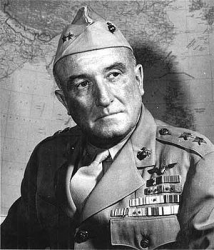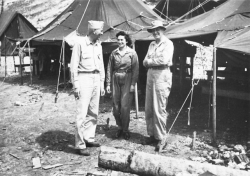
 |
|
|
||
|
Francis Patrick Mulcahy |
||||
|
Engagements: • Occupation of Nicaragua (1912 - 1933)• World War I (1914 - 1918)• Occupation of Haiti (1915 - 1934)• Occupation of Dominican Republic (1916 - 1924)• World War II (1941 - 1945) |
||||
| Biography: | ||||
|
Lieutenant General Francis Patrick Mulcahy was born on 9 March 1894 in Rochester, NY. Mulcahy was a 1914 graduate of the University of Notre Dame. Military Career Francis was commissioned a Second Lieutenant in the U.S. Marine Corps in June 1917, and he began flight training at Naval Air Station Pensacola, FL, that October. World War I He was designated a Naval Aviator in 1918 and transferred to France in July as a member of the First USMC Aviation Force. His unit saw action in World War I as part of the Northern Bombing Group, conducting bombing missions from airfields in Belgium, and between Calais and Dunkirk in France (also spelled Dunkerque). In October 1918, he was awarded his first Navy Distinguished Service Medal. Between the Wars During the period between WWI and WWII, Mulcahy served with Marine aviation on several expeditionary campaigns, including Haiti; Santo Domingo, Nicaragua; Puerto Rico; and in the Virgin Islands. He became one of the Marine's pioneers of providing close air support to ground operations during the inter-war years. He commanded Marine air units throughout the second Nicaraguan Campaign; from July 1931 until all the Marines were pulled out on 1 January 1933. Mulcahy's duties were primarily in the U.S. during the years 1933-40, and he attended several military professional development schools that prepared mid-career officers for higher command. He graduated from the following: U.S. Army Air Corps Tactical School, Maxwell Field, AL; Command and General Staff School, Fort Leavenworth, KS; and the Naval War College at Newport, RI. From 1934-42, Mulcahy received promotions that took him from first lieutenant to brigadier general. World War II Mulcahy was in North Africa as an observer with the British Western Desert Air Force when the 7 December 1941 surprise Japanese attack on Pearl Harbor forced the U.S. into World War II. He remained in North Africa until January 1942, when he was recalled to the U.S. to serve as Chief of Staff of the Second Marine Aircraft Wing. In August '42, he became the Wing's Commanding General. Under his command, the Second Wing deployed overseas during December 1942 - January 1943. As Commander of all Allied Air Forces (also known as the Cactus Air Force; "Cactus" came from the Allied code name for the island) based on Guadalcanal, Mulcahy established his headquarters on the Island and remained there until February 1943. While serving in that command, he earned his second Navy Distinguished Service Medal. From February until April of 1943, he was Chief of Staff to the Commander, Air Forces, Solomon Islands; and from June to September, he was Commander of the New Georgia Air Force operating out of the newly-captured airfield at Munda Point. In the latter command, he earned the Legion of Merit. In early 1944, Mulcahy completed his first tour of duty in the South Pacific and returned to the U.S. He served as Commanding General, USMC Fleet Air, West Coast, from May to September 1944, then returned overseas to succeed Major General Ross E. Rowell as Commanding General of Aircraft, Fleet Marine Force, Pacific. As preparations got underway for the invasion of Okinawa (1 April 1945), Mulcahy was assigned as Commanding General, Tactical Air Force (TAF), Tenth Army, and Commanding General, Second Marine Aircraft Wing. The Second Wing's tactical units, augmented by Army and Navy personnel, formed the nucleus of TAF. He was deployed ashore early to the newly-captured air fields at Yontan and Kadena, and worked to coordinate the combat deployment of his joint-service aviators against the kamikaze threat to the Fleet, and in support of the Tenth Army in its protracted inland campaign. For his service prior to and throughout the Okinawa campaign, Mulcahy was awarded the Army Distinguished Service Medal. On 11 June 1945, he was relieved by Brigadier General Louis E. Woods because of poor health. After being relieved, he returned to the U.S. and, following his hospitalization at the Naval Hospital in San Diego, on 1 December he was assigned to inactive status while he awaited retirement. Mulcahy retired on 1 April 1946 and was promoted to Lieutenant General on the retired list for heroism in combat. Medals and Awards Navy Distinguished Service Medal (2 Awards) Mulcahy also received a Special Letter of Commendation from the Secretary of the Navy (Nicaragua, 1931); and an Army Letter of Commendation (Solomon Islands, 25 July 1943-24 September 1943). Death and Burial Lieutenant General Francis Patrick Mulcahy died on 11 December 1973, at age 79. He was survived by his widow and second wife, Elizabeth Bertrand Mulcahy (died 19 November 1997), who he married on 14 November 1934. He was also survived by 2 children. His first wife, Elinor Wolf Mulcahy, preceded him in death on 26 March 1922; they were married on 23 July 1919. |
||||
| Honoree ID: 3327 | Created by: MHOH | |||
Ribbons
Medals
Badges
Honoree Photos
 |  |  |
 |  |
 |


